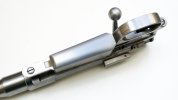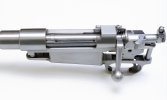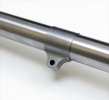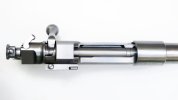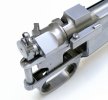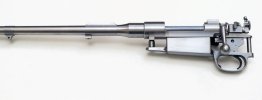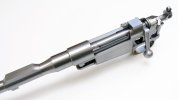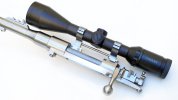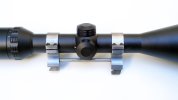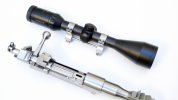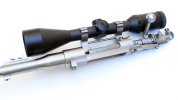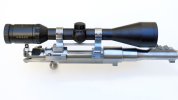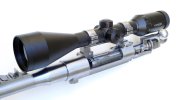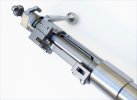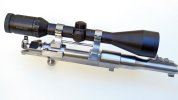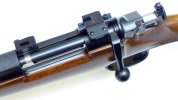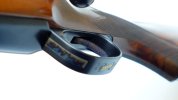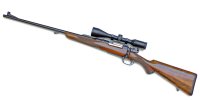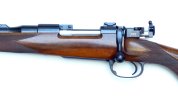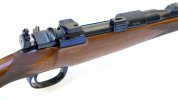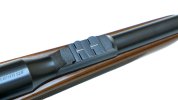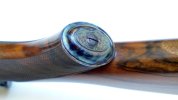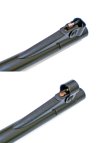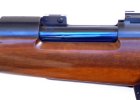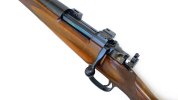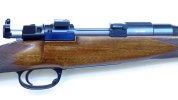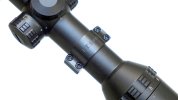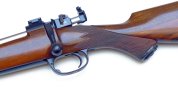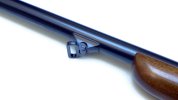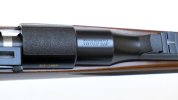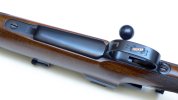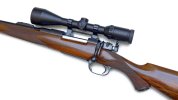Reading this article from African Hunting Gazette made me long for a light, slender 7x57 sporter:
Question is: Which manufacturers offer these other than H&H? They are asking 25.000 for one, which is a tad steep.
Which makers are there out there who can make one to those specifications and to which degree are they comparable to eachother?
Westley Richards, Jeffery, others?
Is Rigby still making these?
As Good Today as They Ever Once Were
If one were to start up a rifle-making company today, according to the conventional wisdom, one would have to offer the newest calibers, the latest composite stocks, a bunch of pseudo-technical gizmos, and all the other over-hyped wrinkles in order to survive.
According to marketing managers, advertising executives, and the editors of most gun magazines, the only thing anyone is interested in today is what's new.
How is it, then, that someone like the new John Rigby & Co. (Gunmakers) Ltd. starts up in London, and their biggest seller by far in the first 18 months is exactly the same rifle that the original London Rigby was offering a century ago?
Of the first dozen rifle orders the company took since it went public in August, 2009, nine have been for magazine rifles, built on Mauser 98 actions, some even with the old Rigby/Mauser stock and provision only for iron or receiver sights. And, most significantly, the majority of orders have been for the 7x57 Mauser or, as it was then known, the .275 Rigby.
No doubt, some of this interest can be put down to either nostalgia or a desire for something different, but a good portion of it is due to the fact that these were extremely fine rifles, and will do everything today that they would a century ago.
Back in the 1980s, Jeff Cooper, who ran the **NOT**PERMITTED** shooting academy in Arizona, came up with an idea for what he called a 都cout rifle. As its name implies, the scout rifle was not a sniper rifle (meaning it was not over-sized, over-weight, over-powered, or encumbered with a huge scope or bipod), nor was it a typical infantry rifle (meaning it would not emphasize firepower).
Instead, it was designed to be compact and light enough to carry comfortably, and quick both to get into action and to operate. Since a scout, by definition, is working on his own, above all things his rifle needs to be functional, durable, and dependable, since he has no one to bail him out. Neither benchrest accuracy nor screaming power is required or even really desirable, since neither can be achieved without some sacrifices elsewhere.
There are all kinds of military and civilian rifles from the past that fit the bill perfectly. The Mauser K98 in its original military form, the British Lee-Enfield No. 5 Mk I (Jungle Carbine), the Winchester Model 1894 lever action any of these is a good scout rifle, by Cooper's definition, exactly as it sits. What Cooper was looking for, though, was a commercial product that eliminated any little niggling objections, such as the K98's weight, the Jungle Carbine's muzzle blast, and the Winchester's accuracy shortcomings.
Among the rifles Cooper considered as a basis for the scout rifle was the Savage 1899 lever action, and various commercial bolt actions. A couple of companies have now come out with models they call 都cout rifles, supposedly based on Cooper's formula, but true to factory form, they have managed to bastardize them one way or another, either by increasing fire power, or making them less ergonomic by giving them large, detachable magazines or riflescopes.
"John Rigby was Mauser's agent in London and not only sold Mauser rifles with the Rigby name, but also imported them and re-sold them to other English gunmakers such as W.J. Jeffery and Westley Richards."
I forgot to mention that Cooper's ideal scout rifle could be carried readily in a saddle scabbard, which is not a major consideration in Africa, but is still a good requirement to ensure the rifle has no unwieldy projections.
* * *
When the Mauser 98 was introduced, the Mauserwerke in Oberndorf almost immediately began producing a line of hunting rifles based on this action. These were followed by different models of the action itself (both shorter and longer, including the famous magnum Mauser inspired by Rigby). The rifles were made in a number of different models.
John Rigby was Mauser's agent in London and not only sold Mauser rifles with the Rigby name, but also imported them and re-sold them to other English gunmakers such as W.J. Jeffery and Westley Richards. Most accounts of rifles sold during this period suggest these companies obtained just the actions and did the rest of the work themselves, or bought barreled actions and stocked them.
Comparing the Rigby and Jeffery rifles listed in their catalogs with complete commercial Mausers offered by Oberndorf, however, it becomes apparent that the English companies, for the most part, brought in complete rifles and engraved their names on the barrels, with additional work on the finest grades, such as installing multi-leaf rear sights.
The configuration of these rifles seems a little odd by today's standards. Fitted only with open sights, or with an aperture sight either on the receiver or striker, they required stocks with more drop, and there is a distinct bend behind the (usual) "half hand" or semi-pistol grip. The barrels are long, while the forends are short, very slim, distinctly tapered, and often left uncheckered. Some were fitted with sling swivels, some were not.
Although the 8x57 Mauser cartridge was the standard military round for the K98, the older 7x57 was the favorite British hunting cartridge. In England, it was known as the .275 Rigby, where it became - and remained - a classic stalking cartridge right up to the present day. It is, without a doubt, one of the finest hunting cartridges ever designed and absolutely letter-perfect for the scout rifle as Jeff Cooper defined it.
The rifle and cartridge combination is first-rate for so many applications, from stag stalking in Scotland to plains game in Africa, and antelope in India and the Himalayas. W.D.M. Bell used one to hunt elephant in the Karamoja, while half a world away, Jim Corbett carried one in the United Provinces of India and killed man-eating tigers with it. In fact, Corbett had two such rifles one that he purchased early in his career before the Great War, and another that was presented to him by the government years later as a token of thanks for his work hunting man-eaters.
The key to the original Mauser's greatness as a stalking rifle is the fact that it did not have a scope mounted on it. This is the same quality that makes the Winchester 1894 so great.
Without a scope, the rifle can be carried balanced in the hand at what the army calls the érail position. The hand wraps around the action at the balance point, and it can be passed easily from right hand to left, depending on fatigue and the terrain. In this position, the rifle is instantly available to be swung to the shoulder for a quick shot at a target that appears for only an instant.
This is no small thing.
Adding a scope to a rifle, however, changes its dynamics radically. For long periods, you almost have to carry it on your shoulder by a sling, which changes the way in which you hunt, and the speed with which you can react to a sudden opportunity or threat. I know professional hunters in Africa who do not have slings on their rifles, and even insist clients remove their slings, to ensure the rifle is carried in a way that it is always ready.
An entire article could be written about how rifles have changed with the addition of scopes, slings, and longer-range cartridges; in terms of close-range hunting, the changes have not been for the better.
Eliminate those changes, and go back to rifles the way they were in 1910 no scopes, medium cartridges intended for practical ranges out to 250 yards, and some without slings, and you have the perfect rifle for some applications. Not all, but some. And, I would suggest, those applications are the ones we most often encounter when hunting game such as bushbuck, impala, kudu in thick cover, and other plains game.
This is what Jeff Cooper envisioned with his unadorned scout rifle. The proposal seemed radically retrogressive to some at the time, but in fact, Col. Cooper was really reinventing a wheel that Mauser and John Rigby had perfected 75 years earlier and which had fallen out of favor, ground under the wheels of so-called progress.
One of the plans of the new London Rigby is to offer the very same models as were in the Rigby catalog in 1910, complete with receiver sights or folding leaves, slim stocks, and no scope mounts. I suspect they will draw a lot of attention from collectors and devotees of the London gun trade, but I also suspect they will sell more than a few to serious hunters who appreciate the virtues of such a rifle.
Question is: Which manufacturers offer these other than H&H? They are asking 25.000 for one, which is a tad steep.
Which makers are there out there who can make one to those specifications and to which degree are they comparable to eachother?
Westley Richards, Jeffery, others?
Is Rigby still making these?
As Good Today as They Ever Once Were
If one were to start up a rifle-making company today, according to the conventional wisdom, one would have to offer the newest calibers, the latest composite stocks, a bunch of pseudo-technical gizmos, and all the other over-hyped wrinkles in order to survive.
According to marketing managers, advertising executives, and the editors of most gun magazines, the only thing anyone is interested in today is what's new.
How is it, then, that someone like the new John Rigby & Co. (Gunmakers) Ltd. starts up in London, and their biggest seller by far in the first 18 months is exactly the same rifle that the original London Rigby was offering a century ago?
Of the first dozen rifle orders the company took since it went public in August, 2009, nine have been for magazine rifles, built on Mauser 98 actions, some even with the old Rigby/Mauser stock and provision only for iron or receiver sights. And, most significantly, the majority of orders have been for the 7x57 Mauser or, as it was then known, the .275 Rigby.
No doubt, some of this interest can be put down to either nostalgia or a desire for something different, but a good portion of it is due to the fact that these were extremely fine rifles, and will do everything today that they would a century ago.
Back in the 1980s, Jeff Cooper, who ran the **NOT**PERMITTED** shooting academy in Arizona, came up with an idea for what he called a 都cout rifle. As its name implies, the scout rifle was not a sniper rifle (meaning it was not over-sized, over-weight, over-powered, or encumbered with a huge scope or bipod), nor was it a typical infantry rifle (meaning it would not emphasize firepower).
Instead, it was designed to be compact and light enough to carry comfortably, and quick both to get into action and to operate. Since a scout, by definition, is working on his own, above all things his rifle needs to be functional, durable, and dependable, since he has no one to bail him out. Neither benchrest accuracy nor screaming power is required or even really desirable, since neither can be achieved without some sacrifices elsewhere.
There are all kinds of military and civilian rifles from the past that fit the bill perfectly. The Mauser K98 in its original military form, the British Lee-Enfield No. 5 Mk I (Jungle Carbine), the Winchester Model 1894 lever action any of these is a good scout rifle, by Cooper's definition, exactly as it sits. What Cooper was looking for, though, was a commercial product that eliminated any little niggling objections, such as the K98's weight, the Jungle Carbine's muzzle blast, and the Winchester's accuracy shortcomings.
Among the rifles Cooper considered as a basis for the scout rifle was the Savage 1899 lever action, and various commercial bolt actions. A couple of companies have now come out with models they call 都cout rifles, supposedly based on Cooper's formula, but true to factory form, they have managed to bastardize them one way or another, either by increasing fire power, or making them less ergonomic by giving them large, detachable magazines or riflescopes.
"John Rigby was Mauser's agent in London and not only sold Mauser rifles with the Rigby name, but also imported them and re-sold them to other English gunmakers such as W.J. Jeffery and Westley Richards."
I forgot to mention that Cooper's ideal scout rifle could be carried readily in a saddle scabbard, which is not a major consideration in Africa, but is still a good requirement to ensure the rifle has no unwieldy projections.
* * *
When the Mauser 98 was introduced, the Mauserwerke in Oberndorf almost immediately began producing a line of hunting rifles based on this action. These were followed by different models of the action itself (both shorter and longer, including the famous magnum Mauser inspired by Rigby). The rifles were made in a number of different models.
John Rigby was Mauser's agent in London and not only sold Mauser rifles with the Rigby name, but also imported them and re-sold them to other English gunmakers such as W.J. Jeffery and Westley Richards. Most accounts of rifles sold during this period suggest these companies obtained just the actions and did the rest of the work themselves, or bought barreled actions and stocked them.
Comparing the Rigby and Jeffery rifles listed in their catalogs with complete commercial Mausers offered by Oberndorf, however, it becomes apparent that the English companies, for the most part, brought in complete rifles and engraved their names on the barrels, with additional work on the finest grades, such as installing multi-leaf rear sights.
The configuration of these rifles seems a little odd by today's standards. Fitted only with open sights, or with an aperture sight either on the receiver or striker, they required stocks with more drop, and there is a distinct bend behind the (usual) "half hand" or semi-pistol grip. The barrels are long, while the forends are short, very slim, distinctly tapered, and often left uncheckered. Some were fitted with sling swivels, some were not.
Although the 8x57 Mauser cartridge was the standard military round for the K98, the older 7x57 was the favorite British hunting cartridge. In England, it was known as the .275 Rigby, where it became - and remained - a classic stalking cartridge right up to the present day. It is, without a doubt, one of the finest hunting cartridges ever designed and absolutely letter-perfect for the scout rifle as Jeff Cooper defined it.
The rifle and cartridge combination is first-rate for so many applications, from stag stalking in Scotland to plains game in Africa, and antelope in India and the Himalayas. W.D.M. Bell used one to hunt elephant in the Karamoja, while half a world away, Jim Corbett carried one in the United Provinces of India and killed man-eating tigers with it. In fact, Corbett had two such rifles one that he purchased early in his career before the Great War, and another that was presented to him by the government years later as a token of thanks for his work hunting man-eaters.
The key to the original Mauser's greatness as a stalking rifle is the fact that it did not have a scope mounted on it. This is the same quality that makes the Winchester 1894 so great.
Without a scope, the rifle can be carried balanced in the hand at what the army calls the érail position. The hand wraps around the action at the balance point, and it can be passed easily from right hand to left, depending on fatigue and the terrain. In this position, the rifle is instantly available to be swung to the shoulder for a quick shot at a target that appears for only an instant.
This is no small thing.
Adding a scope to a rifle, however, changes its dynamics radically. For long periods, you almost have to carry it on your shoulder by a sling, which changes the way in which you hunt, and the speed with which you can react to a sudden opportunity or threat. I know professional hunters in Africa who do not have slings on their rifles, and even insist clients remove their slings, to ensure the rifle is carried in a way that it is always ready.
An entire article could be written about how rifles have changed with the addition of scopes, slings, and longer-range cartridges; in terms of close-range hunting, the changes have not been for the better.
Eliminate those changes, and go back to rifles the way they were in 1910 no scopes, medium cartridges intended for practical ranges out to 250 yards, and some without slings, and you have the perfect rifle for some applications. Not all, but some. And, I would suggest, those applications are the ones we most often encounter when hunting game such as bushbuck, impala, kudu in thick cover, and other plains game.
This is what Jeff Cooper envisioned with his unadorned scout rifle. The proposal seemed radically retrogressive to some at the time, but in fact, Col. Cooper was really reinventing a wheel that Mauser and John Rigby had perfected 75 years earlier and which had fallen out of favor, ground under the wheels of so-called progress.
One of the plans of the new London Rigby is to offer the very same models as were in the Rigby catalog in 1910, complete with receiver sights or folding leaves, slim stocks, and no scope mounts. I suspect they will draw a lot of attention from collectors and devotees of the London gun trade, but I also suspect they will sell more than a few to serious hunters who appreciate the virtues of such a rifle.







